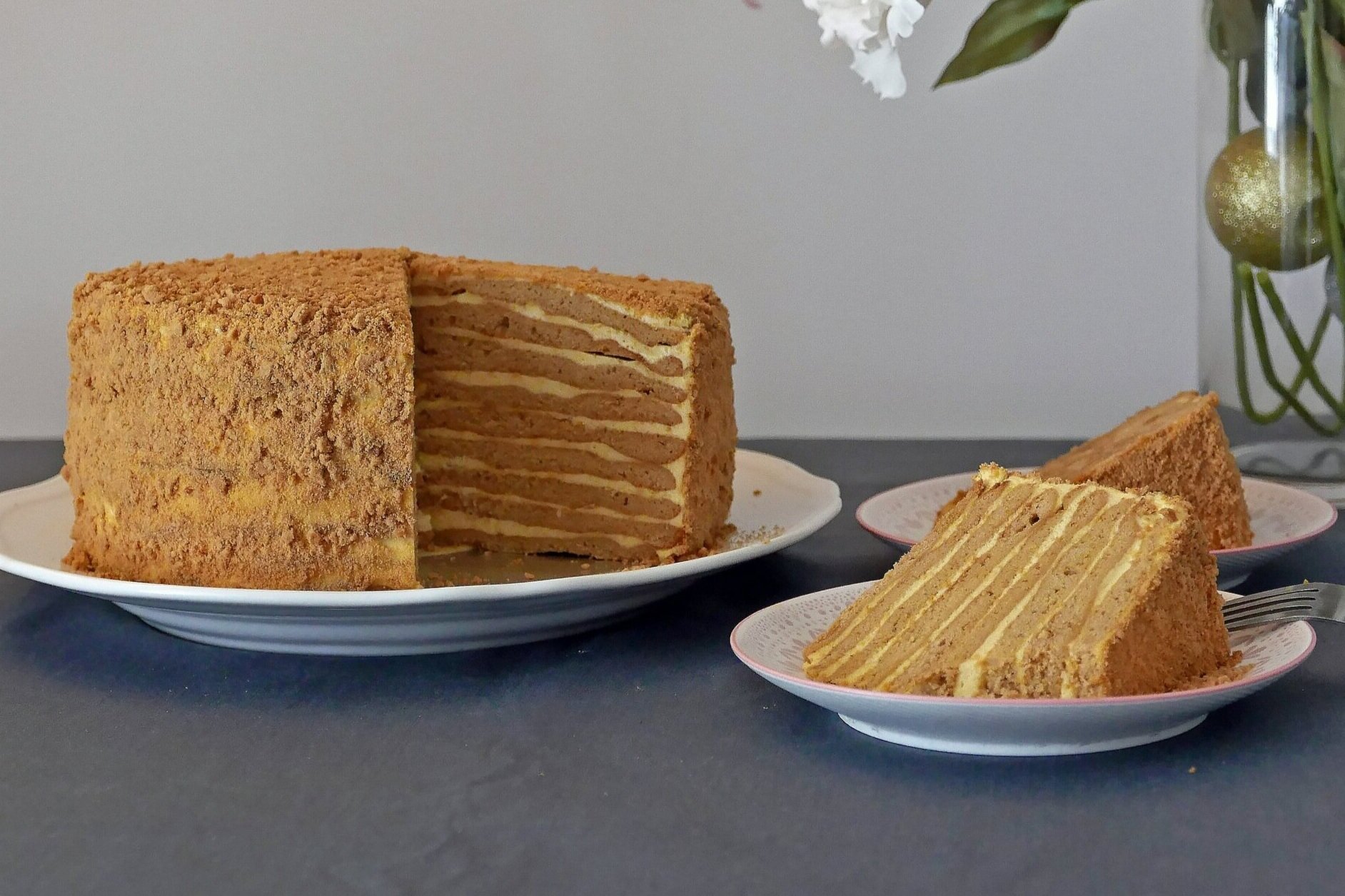Russian Honey Cake (Medovik Torte)
The Recipe
Makes: 1 x 20cm cake
Preparation: 20 minutes
Baking Time: 1 hour
The Medovik Torte or Russian Honey cake was an invention of a young chef in the Imperial Palace of the Russian Empire in the 19th Century.
The Story of the Medovik Torte
The Medovik Torte or Russian Honey cake was an invention of a young chef in the Imperial Palace of the Russian Empire in the 19th Century. It was developed to incorporate honey into a dessert for Empress Elizabeth Alexeyevna, the wife of Alexander I who was not the biggest fan of honey.
The method of heating the honey to a caramel colour allows it to take on a sweet caramel flavor and the inclusion of a sour cream frosting allows it to balance out quite beautifully.
A word or two about honey
Honey, a wonderful golden liquid that has a composition of a complex mixture of sugars, water, vitamins, minerals, pollen, and protein. It is made by these wonderful little black and yellow foragers known as bees, who collect nectar from flowers (or honeydew) near and far, store it in their honey stomachs (crops) and regurgitate it into the little vessels of the hive. The vessel is then fanned with its wings which leads to water being evaporated and the pure honey remaining.
Bees have been going about their business for more than 100 million years according to fossil evidence of these little creatures that have been preserved in resin. Cave paintings in Spain dating back 8,000 years ago show that humans have relied on bees by raiding their nests and collecting the sweet liquid they produce. The earliest evidence of beekeeping was in Ancient Egypt where hives made of clay from the Nile were placed on rafts that travelled up and down the river depending on the season.
Honey bees, honey, and wax were a part of everyday life in the ancient world. The application of honeybees’ by-products was used for culinary purposes, spiritual and religious rituals, embalming, medicinal treatments, and even as a currency.
Honey is classified according to the floral source (monofloral, poly floral, blend) and by region or country. It can be bought in both its raw form and pasteurized form. Raw honey comes straight from the honeycomb and is mashed and filtered to remove the honeycomb and other debris. Honey in its raw state is unadulterated, containing beneficial health and medicinal properties due to the pollen, propolis, antioxidants, natural vitamins, and minerals present. When honey is pasteurized, it results in a smooth clearer liquid and while it is aesthetically pleasing, will contain a loss of vitamins, essential nutrients, and minerals.
INGREDIENTS
CAKE
120g unsalted butter
300g browned honey
150g brown sugar
½ tsp salt
1 tsp cinnamon
500g plain unbleached flour
1.5tsp bicarbonate soda
4 medium eggs
1 tsp vanilla extract
FROSTING
200g browned honey
½ tsp salt
Zest of 1 orange
600g whipping cream.
400g sour cream
METHOD
Preheat the oven to 180’C. Line as many trays as you have with baking paper and draw a 20cm circle on each bit of paper.
To brown the honey, place 500g In a large saucepan on medium heat and allow it to cook for 10 -15 minutes until it becomes a dark caramel colour. Keep a close eye on it as it may boil over. Turn off the heat and pour 300g into a heat-proof bowl and 200g into a separate bowl for the frosting.
The frosting is best made ahead and allowed to set further in the refrigerator so add sour cream to the cooled browned honey, orange zest, and salt. Mix well. Whip the cream in a separate bowl until firm, then fold it into the sour cream mixture until combined. Cover and store in the refrigerator while you make the cake
In the heat-proof bowl containing the browned honey, add sugar, salt, and butter. Heat slowly over a pot of boiling water until the butter has melted and the sugar has dissolved. Take off the heat and whisk in the bicarbonate soda.
Whisk eggs with vanilla in a separate bowl and then slowly whisk this into the honey-sugar mixture.
Finally sift flour and cinnamon and fold into the liquid mixture until combined
Measure 100 g of the cake batter and spread it evenly inside the drawn circle with a spatula. Repeat this on all the baking paper circles. Place in the oven and cook for 5-7 minutes until the batter is cooked. Allow the cake to cool slightly before transferring it to a cooling rack. Repeat this until you have about 10-12 cookie cake rounds. For the last 1-2 cakes you can cook at 130’C for about 8-10 minutes until the cake is nicely browned – this will be used for decorating later. Allow all the layers to cool completely before icing.
Start with the first layer by spreading a small amount of frosting on a 20cm circular cake board. Place the cake layer on top and then add, smoothing out evenly as you go. Keep layering until all the cake has been used up. Finally, ice the top and the sides of the cake. Return to the refrigerator and allow to set.
Blitz up the cooled cake layer that was baked in the oven slightly longer until you have a coarse breadcrumb consistency. When the cake is set, gently but firmly pat the crumbs to the top and the side of the cake.
Cut into generous slices, drizzle with extra honey, and indulge in this gorgeous cake!






